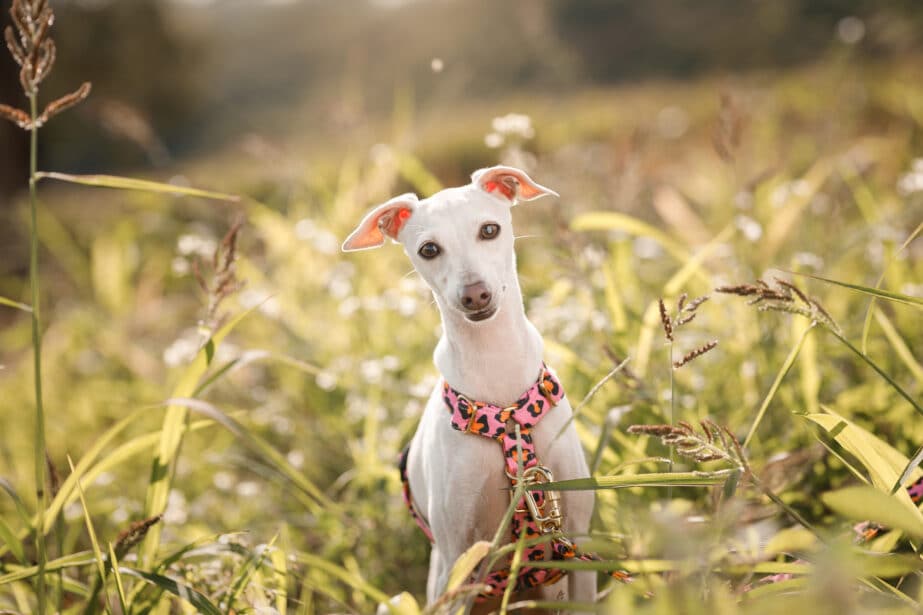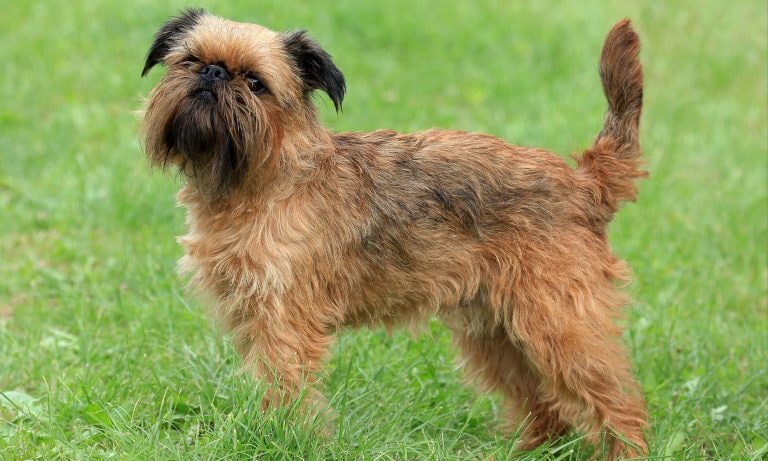Say ciao to the newest love of your life (no, not your nonna’s meatballs). The gentle and affectionate Italian Greyhound is ready to be your amico per la vita (that’s “friend for life” in Italian), ready to keep your lap warm and show off their impressive speed and chase skills (though not at the same time, obviously). These small dogs have a big, infectious personality that makes them instant mood boosters—positive vibes only in an Italian Greyhound’s world, and soon to be in yours.
Breed Snapshot
Temperament:
AlertPlayfulSweet-NaturedCoat Color:
GreySableRedBlackCreamBlue
Best For
Italian Greyhounds are elegant and affectionate pups who require minimal grooming—but they'll also need plenty of exercise due to their high energy levels. Say ciao to these little dogs with a big personality and plenty of love to give.
Italian Greyhound Temperament
The Italian Greyhound’s temperament is surprisingly varied. On the one hand, these hounds can really take off with that infamous Greyhound speed when they see a small critter go by or they just have the urge to do some zoomies. But on the other hand, the Italian Greyhound breed also enjoys quality time snoozing on the couch.
These pups are affectionate with loved ones and even a little mischievous (“Oh, you don’t want me to grab these socks you just folded and run around the house with them in my mouth? Huh… OK, then!”). They may take some time to warm up to strangers but are rarely aggressive toward people.
Italian Greyhounds are great with families and do well with kids, as long as they respect the dog’s boundaries. These thin dogs have fragile bodies, and if given the choice between playing tea party or playing soccer, they’re probably going to choose going for a walk instead. (Besides, everyone knows Italian Greyhounds prefer puppacinos, and it’s called football. Sheesh.) For pet parents living in a multi-dog household, Italian Greyhounds are best suited with other small dogs to prevent injuries they could sustain if playing with a large dog.
When it comes to cats, however, it’s a mixed bag. Some Italian Greyhounds may need to be reminded that cats are friends, not food. The prey instinct can be higher in some Italian Greyhounds than others, and if they see Mr. Fluffy as prey rather than pal, they’ll give chase and hunt.
With their humans, though, Italian Greyhounds are affectionate, sweet and gentle, and ready at any time to accompany you on your next adventure, whether it’s a stroll down the street or a siesta in the afternoon.
How to Care for a Italian Greyhound
While Italian Greyhounds are high energy, they are a fairly low-maintenance breed. Their grooming needs are minimal, but they do require a steady amount of exercise and training. On the plus side, you’ll always have a constant companion who’s eager to brighten your day at any moment’s notice.
Italian Greyhound Health
Italian Greyhounds have a lifespan of 14 to 15 years. Since they tend to be more fragile compared to other dogs their size, they can encounter some health issues, especially as they age. Keep an eye out for these potential health problems to make sure that your pup lives a long, healthy life. Always discuss potential treatment options with your veterinarian.
- Epilepsy: Up to 5 percent of Italian Greyhounds deal with epilepsy. If your dog is prone to seizures, they will typically begin between 6 months and 5 years old. Treatment is typically daily lifelong oral medication.
- Broken Legs: Be careful of situations that could lead to your dog breaking their legs. Italian Greyhounds aren’t necessarily as fragile and delicate as they appear, but be sure to exercise caution when they’re around other, larger dogs. Some pups have even broken a leg when jumping off the couch. They can also be prone to kneecap dislocation, which is called patellar luxation.
- Legg-Calve-Perthes Disease: This is a type of hip degeneration, which may be hereditary. Symptoms usually begin by the time your Italian Greyhound is around 6 months old, and the first sign is limping. Diagnosis is typically made by x-rays and surgery may be required.
- Progressive Retinal Atrophy (PRA): The first sign often noticed in a dog with PRA is night blindness. Affected dogs are sometimes nervous and anxious at night or can bump into objects in dim lighting. PRA is an inherited genetic disease and genetic screening testing is available. While there’s no treatment for gradual blindness, the condition isn’t painful for your Italian Greyhound and dogs with vision issues can do very well.
- Autoimmune Disorders: Italian Greyhounds are prone to a variety of conditions in which the body attacks itself. Commonly affected areas of the body include blood, eyes, skin and neuromuscular system. Diagnostics such as blood tests are usually needed to make a diagnosis, and treatment may vary based on the specific condition, but immunosuppressive therapy and steroids are often used.
- Hypothyroidism: In this endocrine disease, the thyroid gland does not produce enough thyroid hormone resulting in lethargy, weight gain and hair loss. Diagnosis is typically by blood tests and treatment is most often daily medication.
Italian Greyhound History
The origin of the Italian Greyhound starts in a region in the Mediterranean once ruled by the Roman Empire 2,000 years ago, and today is known as Greece and Turkey. The breed was a companion and rumored to be small game hunters in Southern Europe. Just after the end of the Middle Ages, during the Italian Renaissance, Italian Greyhounds became a popular breed among aristocrats, nobility and the wealthy and were frequently included in portrait paintings from that time period.
Since having a toy version of a larger dog breed was widely considered to be a status symbol, it’s no surprise that royalty gravitated to the Italian Greyhound. Queen Victoria, James I, Frederick the Great, Catherine the Great and Anne of Denmark were all fans of this tiny but mighty breed. In fact, an African king reportedly traded 200 cattle for one Italian Greyhound dog.
In 1886, the American Kennel Club formally recognized the Italian Greyhound as a breed. During both World Wars, Italian Greyhounds were nearly depleted throughout Europe. Fortunately, American breeders helped keep them alive and avoid extinction. Since then, Italian Greyhounds have repopulated overseas, and in 2016, the Italian Greyhound won Best in Show at the National Dog Show.
Thinking about adding an Italian Greyhound to your home? You can find a list of reputable breeders on the American Kennel Club’s website. On average, an Italian Greyhound puppy will cost anywhere from $1,400 to $2,000. But for that, you’ll likely get a dog who’s been screened for health and temperament issues, and they might even come with pedigree papers. You can also reach out to Italian Greyhound rescue organizations or visit your local animal shelter to see if any are currently available for adoption.
FAQs
Do Italian Greyhounds shed?
Italian Greyhounds minimally shed. To deal with any excess hair, it’s best to run a warm, wet cloth over their coat. When dust begins to accumulate, gently brush their coat with a rubber hand mitt or soft-bristle brush.
How long do Italian Greyhounds live?
Italian Greyhounds have a lifespan of 14 to 15 years.
Do Italian Greyhounds bark a lot?
Italian Greyhounds are alert barkers who want you to know when something seems amiss. They’re more likely to bark than not to bark, so if you live in an apartment or condo building, be wary of how much noise they might make and how that may be disruptive for your neighbors.
Are Italian Greyhounds good with cats?
Whether or not Italian Greyhounds are good with cats comes down to the individual personalities of each pet. Some Italian Greyhounds have more of a prey instinct than others, and some cats may be friendlier than you might expect. Proceed with caution when introducing an Italian Greyhound to the cat in your life.
What are the most popular Italian Greyhound names?
The most popular Italian Greyhound names are Ravioli, Cannoli, Gelato, Pesto, Biscotti, Roma, Florence, Pompei, Milan, Mario, Luigi, Nitro, Racer, Whiz, Fuel, Bolt, Jiffy, Zip, Zoom, Atomic, Bullet, Derby, Dart, Jett and Turbo. If you’re looking for more inspiration, find more dog names here.
What are the most common Italian Greyhound mixes?
The most common Italian Greyhound mixes are:
- Italian Greyhound-Basenji mix (Italian Greyenji)
- Italian Greyhound-Beagle mix (Italian Greagle)
- Italian Greyhound-Bichon Frise mix (Italian-Bichon)
- Italian Greyhound-Border Collie mix (Italian Border Greyollie)
- Italian Greyhound-Boston Terrier mix (Bostalian)
- Italian Greyhound-Cairn Terrier mix (Italian Cairn)
- Italian Greyhound-Cavalier King Charles Spaniel mix (Italian Cavalier Greyhound)
- Italian Greyhound-Chihuahua mix (Italian Greyhuahua)
- Italian Greyhound-Chinese Crested mix (Italian Greycrested)
- Italian Greyhound-American Eskimo Dog mix (Italian Eskimo)
- Italian Greyhound-Miniature Pinscher mix (Italian Grey Min Pin)
- Italian Greyhound-Poodle mix (Pootalian)
- Italian Greyhound-Jack Russell Terrier mix (Italian Jack Russell)
- Italian Greyhound-Whippet mix (Wiggy)
- Italian Greyhound-Lab mix (Greyador)

Top Takeaways
Are you looking for a lightning-like jolt of energy in your life? Italian Greyhounds will bring all that and more, including loyal companionship and constant affection in the form of nonstop cuddles and nuzzles. For those who want an active pup who still appreciates chill time at home, the Italian Greyhound is a low-maintenance option who will deliver lots of love and laughter for years.
Expert input provided by Dr. Amanda Williams, chief veterinarian and medical director at Furry Friends Adoption, Clinic & Ranch, and Sparky Serka and Bethany TK, head trainers at The Puppy Academy.

Search for Adoptable Italian Greyhounds Near You
Top Italian Greyhound Names
These are the top Italian Greyhound names as chosen by Chewy's pet parents!
Female Names
- Luna
- Bella
- Olive
- Mia
- Millie
- Piper
- Sophie
- Ellie
- Lucy
- Penny
Male Names
- Enzo
- Milo
- Luca
- Ziggy
- Finn
- Luigi
- Leo
- Rocco
- Giuseppe
- Nico
Share:


























